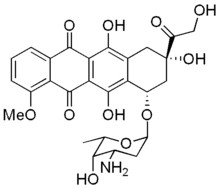Sponsored by: EORTC Soft Tissue and Bone Sarcoma Cooperative Group
RATIONALE: Drugs used in chemotherapy such as doxorubicin and ifosfamide use different ways to stop tumor cells from dividing so they stop growing or die. It is not yet known whether doxorubicin is more effective with or without ifosfamide in treating soft tissue sarcoma.
PURPOSE: Randomized phase III trial to compare the effectiveness of doxorubicin with or without ifosfamide in treating patients who have locally advanced or metastatic soft tissue sarcoma.
Study Type: Interventional
Study Design: Treatment
OBJECTIVES:
* Compare the progression-free and overall survival of patients with locally advanced or metastatic soft tissue sarcoma treated with doxorubicin with vs. without ifosfamide as first-line therapy.
* Compare the response in patients treated with these regimens.
* Compare the treatment-related mortality of patients treated with these regimens.
* Compare the toxicity of these regimens in these patients.
OUTLINE: This is a randomized, open-label, multicenter study. Patients are stratified according to WHO performance status (0 vs. 1), age group (less than 50 years of age vs. 50 years of age and over), presence of liver metastases (yes vs. no), histological grade (2 vs. 3), and participating center. Patients are randomized to 1 of 2 treatment arms.
* Arm I: Patients receive doxorubicin IV on day 1.
* Arm II: Patients receive doxorubicin IV on days 1-3 and ifosfamide IV over 4 hours on days 1-4. In both arms, treatment repeats every 3 weeks for up to 6 courses in the absence of disease progression or unacceptable toxicity. * Patients are followed every 8 weeks until disease progression and then every 12 weeks thereafter.
Ages eligible for study: 18 years - 60 years, both genders
DISEASE CHARACTERISTICS:
* Histologically confirmed soft tissue sarcoma
* Locally advanced unresectable * OR metastatic disease
* High-grade (grade 2-3) disease according to the FNLCC grading system
NOTE: * Disease that could prove resectable (including pulmonary metastasectomy) after a response to chemotherapy is allowed
* The following tumor types are eligible:
* Malignant fibrous histiocytoma
* Myxoid and round cell liposarcoma, pleomorphic liposarcoma, or dedifferentiated liposarcoma
* Pleomorphic rhabdomyosarcoma
* Synovial sarcoma
* Myxofibrosarcoma, intermediate and high-grade
* Fibrosarcoma
* Leiomyosarcoma
* Angiosarcoma
* Malignant peripheral nerve sheath tumor
* Epithelioid sarcoma
* The following tumor types are not eligible:
* Gastrointestinal stromal tumor
* Uterine leiomyosarcoma
* Mixed mesodermal tumor
* Chondrosarcoma
* Malignant mesothelioma
* Neuroblastoma
* Osteosarcoma
* Ewing's sarcoma/primitive neuroectodermal tumor
* Desmoplastic small round cell tumor
* Embryonal rhabdomyosarcoma
* Alveolar soft part sarcoma
* Must have a measurable lesion with clinical evidence of progression within the past 6 weeks
* Osseous lesions and pleural effusions are not considered measurable
* No known or symptomatic CNS metastases
Patient Characteristics:
Performance status
* WHO 0-1
Hematopoietic
* Absolute neutrophil count at least 2,000/[mm.sup.3]
* Platelet count at least 100,000/[mm.sup.3]
Hepatic
* Bilirubin no greater than 1.8 mg/dL
* Albumin at least 2.5 g/dL
Renal
* Creatinine no greater than 1.4 mg/dL OR
* Creatinine clearance greater than 65 mL/min
Cardiovascular
* LVEF normal by echocardiography or MUGA
* No history of cardiovascular disease
Other
* Not pregnant
* Negative pregnancy test
* Fertile patients must use effective contraception
* No other severe medical illness
* No psychosis
* No other prior or concurrent malignancy except adequately treated carcinoma in situ of the cervix or basal cell skin cancer
* No psychological, familial, sociological, or geographical condition that would preclude study compliance and follow-up schedule
PRIOR CONCURRENT THERAPY:
Chemotherapy
* No prior chemotherapy for advanced or metastatic disease
* Prior adjuvant chemotherapy allowed provided there was no disease progression within 6 months after completion of treatment
Radiotherapy
* No prior radiotherapy to the sole index lesion
Location and Contact Information:
Institute of Cancer Research--UK, Sutton, England, SM2 5NG, United Kingdom; Ian Robert Judson, MA, MD, FRCP Study Chair, National Cancer Research Institute (NCRI) Tel: 44-208-722-4302
Denmark United Kingdom, England
A total of 450 patients will be accrued for this study within 4 years
Study ID Numbers CDR0000302584; EORTC-62012
NLM Identifier NCT00061984
COPYRIGHT 2003 Journal of Drugs in Dermatology
COPYRIGHT 2003 Gale Group



